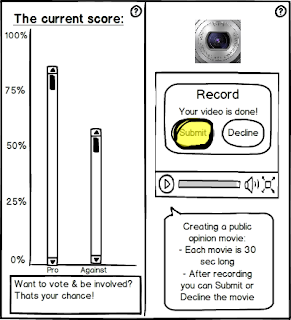Today we had a concept presentation at the Microsoft Accelerator with the four other groups.
Our presentation went really well. A link to the presentation slides can be found here.
Here is the presentation at Microsoft:
We got some very constructive criticism. The main one was about the stand we want to use. The circular advertisement stand, they said, takes up more space than we can use, since we want to use LCD screens inside (as per our past posts). The circular shape might put a barrier between people, and since discussion is one of the main reasons to put a physical stand rather than use an app, hindering conversation is one thing we don't want to do.
Spock commented on the possibility of vandalism when recording public opinion, and that a recorded video might be very embarrassing. Also, he thinks that maybe listening to others' opinions will skew the resuts.
Henit asked about time aspect: how long does the user have to stand in front of the system? This is important because we don't want to miss the votes of people who don't have much time. Also, she recommends that if we continue with recording the public's opinion, that the person who recorded their idea gets some credit for what they added to the discourse, like an option to put his video on Facebook. She also suggested we let people post their opinions from home.
Gilat also talked about the time aspect of our device. She suggested doing a user study to figure out what is the minimum time needed to get all the information. She added that it is important to remember that not all issues are for and against, and that some of the issues might be between two options.
Amiel loved the idea of the public opinion video clips. He told us to consider presenting the information in another way rather than video, such as static text.
Our presentation went really well. A link to the presentation slides can be found here.
Here is the presentation at Microsoft:
We got some very constructive criticism. The main one was about the stand we want to use. The circular advertisement stand, they said, takes up more space than we can use, since we want to use LCD screens inside (as per our past posts). The circular shape might put a barrier between people, and since discussion is one of the main reasons to put a physical stand rather than use an app, hindering conversation is one thing we don't want to do.
Spock commented on the possibility of vandalism when recording public opinion, and that a recorded video might be very embarrassing. Also, he thinks that maybe listening to others' opinions will skew the resuts.
Henit asked about time aspect: how long does the user have to stand in front of the system? This is important because we don't want to miss the votes of people who don't have much time. Also, she recommends that if we continue with recording the public's opinion, that the person who recorded their idea gets some credit for what they added to the discourse, like an option to put his video on Facebook. She also suggested we let people post their opinions from home.
Gilat also talked about the time aspect of our device. She suggested doing a user study to figure out what is the minimum time needed to get all the information. She added that it is important to remember that not all issues are for and against, and that some of the issues might be between two options.
Amiel loved the idea of the public opinion video clips. He told us to consider presenting the information in another way rather than video, such as static text.






































.jpg)











